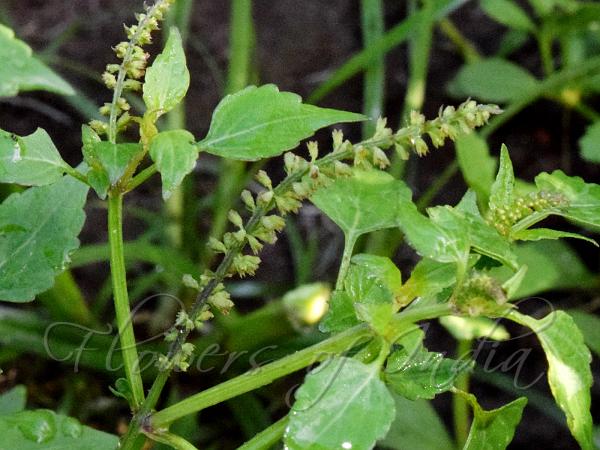|
| Musk Basil |
|

|

| File size | 524368 |
| Original date | 5/18/15 7:08 AM |
| Resolution | 1600 x 1200 |
| Flash | Flash fired, return detected |
| Focal length | 55.0mm |
| Exposure time | 1/200s |
| Aperture | 25.0 |
| Focus Distance | |
| Metering Mode | Multi-segment |
| Camera make | NIKON CORPORATION |
| Camera model | NIKON D3300 |
| Sensor type | OneChipColorArea |
|
|
|
|
Photo: |
Botanical name: Basilicum polystachyon Family: Lamiaceae (Mint family)
Synonyms: Lehmannia ocymoidea, Ocimum polystachyon, Moschosma polystachyon
Synonyms: Lehmannia ocymoidea, Ocimum polystachyon, Moschosma polystachyon
Musk Basil is an annual herb with stem up to 1.22 m
tall, much branched, pointedly 4-angular, shallowly furrowed, the
angles pustular with tubercles tipped by falling off bristles, the
nodes annulate with very small hairs, otherwise hairless. Leaves are
broadly ovate to oval-rhomboid, 2.6-7.5 x 2-4.3 cm, flat to
wedge-shaped at base, tapering, irregularly rounded toothed,
sawtoothed, thin, membranous, scaberulous above, hairless beneath.
Leaf-stalks are 1.7-5 cm. Flowers are borne in linear racemes 5-6 cm
long, verticils often 6-flowered. Floral leaves are
inverted-spoon-shaped to oval-oblong, 1 mm long, aristate.
Flower-stalks are 1 mm long, bristlyulous. Calyx is 1.75-2 mm long,
longer in fruit; tube subswollen, 1.25 mm long, bristlyulous with gland
tipped hairs at base without, somewhat inflated at base in front; upper
lip broadly ovate, 0.75 x 1 mm, tapering; lower lip as long as upper,
4-toothed, the lateral ones triangular-ovate, the anterior ones
triangular-lanceshaped, tapering, aristate. Flowers are 2.5-3 mm long,
mauvish-pink; tube straight, bell-shaped, 1.75 mm long, hairless
without, thinly velvet-hairy within; upper lip erect, 3-lobed, lobes
rounded, central one 2-fid; lower lip slightly longer, oval-oblong,
flat, bristlyulous ventrally. Stamens didymous, included; anterior
filaments longer than posterior all hairless; anthers 2-celled, the
cells continuous. Style hairless, shortly 2-fid at tip; branches
oblong-oval. Nutlets broadly ellipsoid, 0.8 mm long, compressed, dark
brown. Musk Basil is found in Tropical Africa and Indo-Malesia.
| Identification credit: S. Kasim | Photographed in Trichirapally, Tamil Nadu. |
• Is this flower misidentified? If yes,